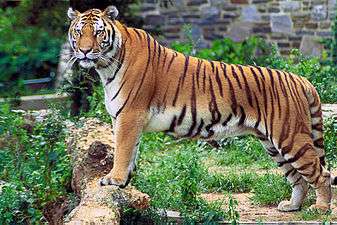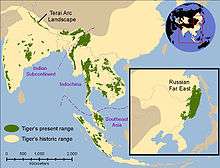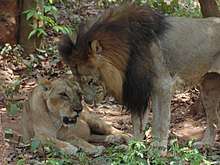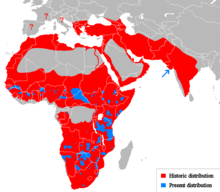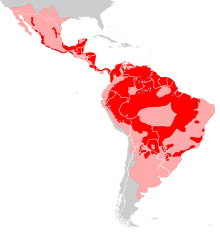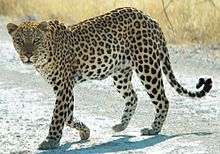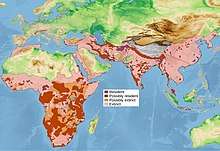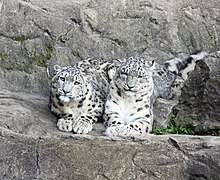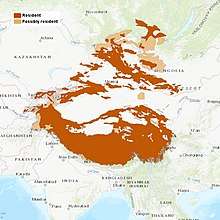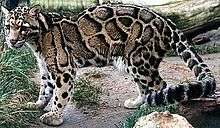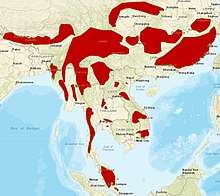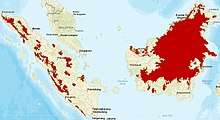Pantherinae
Pantherinae is a subfamily within the family Felidae, which was named and first described by Reginald Innes Pocock in 1917.[2] The Pantherinae and the Felinae diverged from a common ancestor between 10.8 and 11.5 million years ago.[3][4]
| Pantherinae[1] | |
|---|---|
 | |
| Pantherinae subfamily members (from left): jaguar, leopard, lion, tiger, snow leopard and clouded leopard | |
| Scientific classification | |
| Kingdom: | Animalia |
| Phylum: | Chordata |
| Class: | Mammalia |
| Order: | Carnivora |
| Suborder: | Feliformia |
| Family: | Felidae |
| Subfamily: | Pantherinae Pocock, 1917 |
| Genera | |
Characteristics
The members of the Pantherinae have an imperfectly ossified suspensorium of the hyoid apparatus. It is connected to the base of the base skull by an elastic tendon, which provides mobility to the larynx.[2] They have a single rounded vocal fold with a thick mucosal lining, a large vocalis muscle and a large cricothyroid muscle with long and narrow membranes. The vocal fold is longer than 9 mm (0.35 in). This structure of the larynx enables them to roar.[5]
Their rhinarium is flat and, at most, only barely reaches the dorsal side of the nose. The area between the nostrils is narrow and not extended sidewards as in the Felinae.[6]
Evolution
The divergence of Pantherinae from Felinae has been estimated to have occurred between six and ten million years ago.[7] DNA analysis suggests that the snow leopard Uncia uncia is basal to the entire Pantherinae and should be renamed Panthera uncia. There is also evidence of distinct markers for the mitochondrial genome for Felidae.[8][9]
Results of a DNA-based study indicate that the tiger (Panthera tigris) branched off first, followed by the jaguar (P. onca), the lion (P. leo), then the leopard (P. pardus) and snow leopard (P. uncia).[10] The oldest known skull, dated to 2.16 to 2.55 mya, belongs to the Longdan tiger (Panthera zdanskyi), which is seen as a sister species to the modern tiger.[11]
Felis pamiri, formerly referred to as Metailurus, is now considered a probable relative of extant Pantherinae.[12]
Classification
Pocock originally defined the Pantherinae as comprising the genera Panthera and Uncia.[2]
Living genera
The following table shows the extant taxa within the Pantherinae, grouped according to the traditional phenotypical classification.[13]
| Genus | Species | IUCN Red List status and distribution |
|---|---|---|
| Panthera Oken, 1816[14] | Tiger (P. tigris) (Linnaeus, 1758)[15]
|
EN[16]
|
| Lion (P. leo) (Linnaeus, 1758)[17]
|
VU[18]
| |
| Jaguar (P. onca) (Linnaeus, 1758)[19]
|
NT[20]
| |
| Leopard (P. pardus) (Linnaeus, 1758)[21]
|
VU[22]
| |
| Snow leopard (P. uncia) (Schreber, 1775)[23]
|
VU[24]
| |
| Neofelis Gray, 1867[25] | Clouded leopard (N. nebulosa) (Griffith, 1821)[26]
|
VU[27]
|
| Sunda clouded leopard (N. diardi) (Cuvier, 1823)[28]
|
VU[29]
| |
Fossil taxa
See also
References
- Wozencraft, W.C. (2005). "Order Carnivora". In Wilson, D.E.; Reeder, D.M (eds.). Mammal Species of the World: A Taxonomic and Geographic Reference (3rd ed.). Johns Hopkins University Press. pp. 545–548. ISBN 978-0-8018-8221-0. OCLC 62265494.
- Pocock, R. I. (1917). "The Classification of existing Felidae". The Annals and Magazine of Natural History. Series 8. XX: 329–350. doi:10.1080/00222931709487018.
- Johnson, W. E.; Eizirik, E.; Pecon-Slattery, J.; Murphy, W. J.; Antunes, A.; Teeling, E.; O'Brien, S. J. (2006). "The late Miocene radiation of modern Felidae: a genetic assessment". Science. 311 (5757): 73–77. Bibcode:2006Sci...311...73J. doi:10.1126/science.1122277. PMID 16400146.
- Li, G.; Davis, B. W.; Eizirik, E.; Murphy, W. J. (2016). "Phylogenomic evidence for ancient hybridization in the genomes of living cats (Felidae)". Genome Research. 26 (1): 1–11. doi:10.1101/gr.186668.114. PMC 4691742. PMID 26518481.
- Hast, M. H. (1989). "The larynx of roaring and non-roaring cats". Journal of Anatomy. 163: 117–121. PMC 1256521. PMID 2606766.
- Hemmer, H. (1966). "Untersuchungen zur Stammesgeschichte der Pantherkatzen (Pantherinae). Teil I" [Researching the phylogenetic history of the Pantherinae. Part I]. Veröffentlichungen der Zoologischen Staatssammlung München. 11: 1–121.
- Johnson, W.E.; Eizirik, E.; Pecon-Slattery, J.; Murphy, W.J.; Antunes, A.; Teeling, E.; O'Brien, S.J. (2006). "The Late Miocene radiation of modern Felidae: A genetic assessment". Science. 311 (5757): 73–77. Bibcode:2006Sci...311...73J. doi:10.1126/science.1122277. PMID 16400146.
- Wei, Lei; Wu, Xiaobing; Jiang, Zhigang (2008). "The complete mitochondrial genome structure of snow leopard Panthera uncia". Molecular Biology Reports. 36 (5): 871–878. doi:10.1007/s11033-008-9257-9. PMID 18431688.
- Yu, Li; Qing-wei, Li; Ryder, O.A.; Ya-ping, Zhang (2004). "Phylogenetic relationships within mammalian order Carnivora indicated by sequences of two nuclear DNA genes" (PDF). Molecular Phylogenetics and Evolution. 33 (3): 694–705. doi:10.1016/j.ympev.2004.08.001. PMID 15522797. Archived from the original (PDF) on 2011-07-07.
- Yu, L.; Zhang, Y. P. (2005). "Phylogenetic studies of pantherine cats (Felidae) based on multiple genes, with novel application of nuclear beta fibrinogen intron 7 to carnivores". Molecular Phylogenetics and Evolution. 35 (2): 483–495. doi:10.1016/j.ympev.2005.01.017. PMID 15804417.
- Mazák, J. H.; Christiansen, P.; Kitchener, A. C. (2011). "Oldest Known Pantherine Skull and Evolution of the Tiger". PLoS ONE. 6 (10): e25483. Bibcode:2011PLoSO...625483M. doi:10.1371/journal.pone.0025483. PMC 3189913. PMID 22016768.
- Geraads, D.; Peigné, S. (2016). "Re-Appraisal of Felis pamiri Ozansoy, 1959 (Carnivora, Felidae) from the Upper Miocene of Turkey: the Earliest Pantherine Cat?". Journal of Mammalian Evolution. 24 (4): 415–425. doi:10.1007/s10914-016-9349-6.
- Kitchener, A. C.; Breitenmoser-Würsten, C.; Eizirik, E.; Gentry, A.; Werdelin, L.; Wilting, A.; Yamaguchi, N.; Abramov, A. V.; Christiansen, P.; Driscoll, C.; Duckworth, J. W.; Johnson, W.; Luo, S.-J.; Meijaard, E.; O’Donoghue, P.; Sanderson, J.; Seymour, K.; Bruford, M.; Groves, C.; Hoffmann, M.; Nowell, K.; Timmons, Z.; Tobe, S. (2017). "A revised taxonomy of the Felidae: The final report of the Cat Classification Task Force of the IUCN Cat Specialist Group" (PDF). Cat News (Special Issue 11): 64−75.
- Oken, L. (1816). "1. Art, Panthera". Lehrbuch der Zoologie. 2. Abtheilung. Jena: August Schmid & Comp. p. 1052.
- Linnaeus, C. (1758). "Felis tigris". Caroli Linnæi Systema naturæ per regna tria naturæ, secundum classes, ordines, genera, species, cum characteribus, differentiis, synonymis, locis. Tomus I (decima, reformata ed.). Holmiae: Laurentius Salvius. p. 41.
- Goodrich, J.; Lynam, A.; Miquelle, D.; Wibisono, H.; Kawanishi, K.; Pattanavibool, A.; Htun, S.; Tempa, T.; Karki, J.; Jhala, Y.; Karanth, U. (2015). "Panthera tigris". IUCN Red List of Threatened Species. 2015: e.T15955A50659951. doi:10.2305/IUCN.UK.2015-2.RLTS.T15955A50659951.en.
- Linnaeus, C. (1758). "Felis leo". Caroli Linnæi Systema naturæ per regna tria naturæ, secundum classes, ordines, genera, species, cum characteribus, differentiis, synonymis, locis. Tomus I (decima, reformata ed.). Holmiae: Laurentius Salvius. p. 41.
- Bauer, H.; Packer, C.; Funston, P. F.; Henschel, P.; Nowell, K. (2016). "Panthera leo". IUCN Red List of Threatened Species. 2016. doi:10.2305/IUCN.UK.2016-3.RLTS.T15951A107265605.en.
- Linnaeus, C. (1758). "Felis onca". Caroli Linnæi Systema naturæ per regna tria naturæ, secundum classes, ordines, genera, species, cum characteribus, differentiis, synonymis, locis. Tomus I (decima, reformata ed.). Holmiae: Laurentius Salvius. p. 42. (in Latin)
- Quigley, H.; Foster, R.; Petracca, L.; Payan, E.; Salom, R.; Harmsen, B. (2017). "Panthera onca". IUCN Red List of Threatened Species. 2017: e.T15953A123791436. doi:10.2305/IUCN.UK.2017-3.RLTS.T15953A50658693.en.{{cite iucn}}: error: |doi= / |page= mismatch (help)
- Linnaeus, C. (1758). "Felis pardus". Caroli Linnæi Systema naturæ per regna tria naturæ, secundum classes, ordines, genera, species, cum characteribus, differentiis, synonymis, locis. Tomus I (decima, reformata ed.). Holmiae: Laurentius Salvius. p. 41−42.
- Stein, A. B.; Athreya, V.; Gerngross, P.; Balme, G.; Henschel, P.; Karanth, U.; Miquelle, D.; Rostro, S.; Kamler, J. F. & Laguardia, A. (2016). "Panthera pardus". IUCN Red List of Threatened Species. 2016: e.T15954A102421779. doi:10.2305/IUCN.UK.2016-1.RLTS.T15954A50659089.en.{{cite iucn}}: error: |doi= / |page= mismatch (help)
- Schreber, J. C. D. (1777). "Die Unze". Die Säugethiere in Abbildungen nach der Natur mit Beschreibungen. Erlangen: Wolfgang Walther. pp. 386–387.
- McCarthy, T.; Mallon, D.; Jackson, R.; Zahler, P.; McCarthy, K. (2017). "Panthera uncia". IUCN Red List of Threatened Species. 2017: e.T22732A50664030. doi:10.2305/IUCN.UK.2017-2.RLTS.T22732A50664030.en.
- Gray, J. E. (1867). "Notes on the skulls of the Cats. 5. Neofelis". Proceedings of the Scientific Meetings of the Zoological Society of London. 1867: 265–266.
- Griffith, E. (1821). "Felis nebulosa". General and particular descriptions of the vertebrated animals arranged comfortably to the modern discoveries and improvements in zoology. London: Baldwin, Cradock & Joy. p. 37.
- Grassman, L.; Lynam, A.; Mohamad, S.; Duckworth, J. W.; Borah, J.; Willcox, D.; Ghimirey, Y.; Reza, A. & Rahman, H. (2016). "Neofelis nebulosa". IUCN Red List of Threatened Species. 2016: e.T14519A97215090. doi:10.2305/IUCN.UK.2016-1.RLTS.T14519A97215090.en.
- Cuvier, G. (1823). "Recherches sur les ossemens fossiles; ou, l'on retablit les caracteres de plusiers animaux dont les revolutions du globe ont detruit les especes". Les Ruminans et les Carnassiers Fossiles, Volume IV. Paris: G. Dufour & E. d'Ocagne.
- Hearn, A.; Ross, J.; Brodie, J.; Cheyne, S.; Haidir, I. A.; Loken, B.; Mathai, J.; Wilting, A.; McCarthy, J. (2016). "Neofelis diardi". IUCN Red List of Threatened Species. 2016: e.T136603A97212874. doi:10.2305/IUCN.UK.2015-4.RLTS.T136603A50664601.en.{{cite iucn}}: error: |doi= / |page= mismatch (help)
External links
- Choi, C. Q. (2011). "World's Oldest Tiger Species Discovered". Live Science. Retrieved 2019-06-30.
